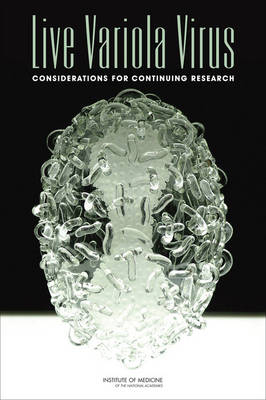
Live Variola Virus
Considerations for Continuing Research
Seiten
2009
National Academies Press (Verlag)
978-0-309-13690-7 (ISBN)
National Academies Press (Verlag)
978-0-309-13690-7 (ISBN)
Smallpox was a devastating disease that decimated human populations for centuries, and its eradication in 1980 was a monumental achievement for the global health community. Since then the remaining known strains of its causative agent, variola virus, have been contained in two World Health Organization (WHO)-approved repositories.
In 1999, the World Health Assembly (WHA) debated the issue of destroying these remaining strains. Arguments were presented on the need to retain the live virus for use in additional important research, and the decision to destroy the virus was deferred until this research could be completed. In that same year, the Institute of Medicine (IOM) convened a consensus committee to explore scientific needs for the live virus.
In the ten years since the first IOM report, the scientific, political, and regulatory environments have changed. In this new climate, the IOM was once again tasked to consider scientific needs for live variola virus. The committee evaluated the scientific need for live variola virus in four areas: development of therapeutics, development of vaccines, genomic analysis, and discovery research.
Table of Contents
Front Matter
Summary
1 Introduction
2 Overview of Smallpox and Its Surveillance and Control
3 Comparative Poxvirology
4 Animal Models Using Variola and Other Orthopoxviruses
5 Genomic Analysis
6 Development of Therapeutics
7 Development of Vaccines
8 Methods for Detection and Diagnosis
9 Discovery Research
10 Conclusions and Recommendations
Appendix: Variola Strains Used to Validate Diagnostic and Detection Assays
In 1999, the World Health Assembly (WHA) debated the issue of destroying these remaining strains. Arguments were presented on the need to retain the live virus for use in additional important research, and the decision to destroy the virus was deferred until this research could be completed. In that same year, the Institute of Medicine (IOM) convened a consensus committee to explore scientific needs for the live virus.
In the ten years since the first IOM report, the scientific, political, and regulatory environments have changed. In this new climate, the IOM was once again tasked to consider scientific needs for live variola virus. The committee evaluated the scientific need for live variola virus in four areas: development of therapeutics, development of vaccines, genomic analysis, and discovery research.
Table of Contents
Front Matter
Summary
1 Introduction
2 Overview of Smallpox and Its Surveillance and Control
3 Comparative Poxvirology
4 Animal Models Using Variola and Other Orthopoxviruses
5 Genomic Analysis
6 Development of Therapeutics
7 Development of Vaccines
8 Methods for Detection and Diagnosis
9 Discovery Research
10 Conclusions and Recommendations
Appendix: Variola Strains Used to Validate Diagnostic and Detection Assays
1 Front Matter; 2 Summary; 3 1 Introduction; 4 2 Overview of Smallpox and Its Surveillance and Control; 5 3 Comparative Poxvirology; 6 4 Animal Models Using Variola and Other Orthopoxviruses; 7 5 Genomic Analysis; 8 6 Development of Therapeutics; 9 7 Development of Vaccines; 10 8 Methods for Detection and Diagnosis; 11 9 Discovery Research; 12 10 Conclusions and Recommendations; 13 Appendix: Variola Strains Used to Validate Diagnostic and Detection Assays
| Erscheint lt. Verlag | 14.11.2009 |
|---|---|
| Verlagsort | Washington |
| Sprache | englisch |
| Maße | 152 x 229 mm |
| Themenwelt | Medizin / Pharmazie ► Medizinische Fachgebiete ► Mikrobiologie / Infektologie / Reisemedizin |
| ISBN-10 | 0-309-13690-3 / 0309136903 |
| ISBN-13 | 978-0-309-13690-7 / 9780309136907 |
| Zustand | Neuware |
| Haben Sie eine Frage zum Produkt? |
Mehr entdecken
aus dem Bereich
aus dem Bereich
und Erste Hilfe an Bord
Buch | Softcover (2024)
MWV Medizinisch Wissenschaftliche Verlagsgesellschaft
CHF 55,90


